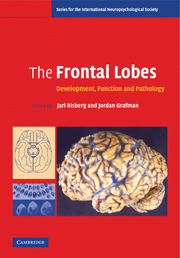Book contents
- Frontmatter
- Contents
- Contributors
- From the series editor
- Introduction
- 1 Evolutionary aspects on the frontal lobes
- 2 Organization of the principal pathways of prefrontal lateral, medial, and orbitofrontal cortices in primates and implications for their collaborative interaction in executive functions
- 3 Human prefrontal cortex: processes and representations
- 4 A microcircuit model of prefrontal functions: ying and yang of reverberatory neurodynamics in cognition
- 5 Prefrontal cortex: typical and atypical development
- 6 Case studies of focal prefrontal lesions in man
- 7 Left prefrontal function and semantic organization during encoding and retrieval in healthy and psychiatric populations
- 8 Clinical symptoms and neuropathology in organic dementing disorders affecting the frontal lobes
- Index
- Plate section
- References
2 - Organization of the principal pathways of prefrontal lateral, medial, and orbitofrontal cortices in primates and implications for their collaborative interaction in executive functions
Published online by Cambridge University Press: 11 September 2009
- Frontmatter
- Contents
- Contributors
- From the series editor
- Introduction
- 1 Evolutionary aspects on the frontal lobes
- 2 Organization of the principal pathways of prefrontal lateral, medial, and orbitofrontal cortices in primates and implications for their collaborative interaction in executive functions
- 3 Human prefrontal cortex: processes and representations
- 4 A microcircuit model of prefrontal functions: ying and yang of reverberatory neurodynamics in cognition
- 5 Prefrontal cortex: typical and atypical development
- 6 Case studies of focal prefrontal lesions in man
- 7 Left prefrontal function and semantic organization during encoding and retrieval in healthy and psychiatric populations
- 8 Clinical symptoms and neuropathology in organic dementing disorders affecting the frontal lobes
- Index
- Plate section
- References
Summary
Overview
Ideas about the prefrontal cortex have changed drastically during the past century. Situated at the rostral pole of the brain, the prefrontal cortex was traditionally considered to be the seat of intelligence. Damage to the prefrontal cortex, however, does not affect overall intelligence in humans, but has detrimental effects on executive function. Converging lines of evidence indicate that the prefrontal cortex is an action-oriented region, guiding behavior by selecting relevant signals to accomplish the task at hand.
The prefrontal cortex is in a strategic position to exercise executive control. It receives information from most other cortical areas and subcortical structures and is connected with specialized oculomotor centers for searching the environment, and with motor control systems for action. These functions have been associated with the caudal parts of the lateral prefrontal cortex, namely areas 8 and the caudal part of area 46. These caudal lateral areas are connected with neighboring premotor as well as early-processing sensory association areas and with intraparietal visuomotor areas. However, the lateral prefrontal cortex is considerably more extensive, and includes, in addition, the more anteriorly situated areas around the principal sulcus (rostral area 46), area 9 on the dorsolateral surface, area 12 on the ventrolateral surface, and area 10 at the frontal pole, all of which have been associated with cognitive functions and executive control. Figure 2.1B shows the lateral prefrontal cortex and its relationship to the adjacent premotor/motor cortical system.
- Type
- Chapter
- Information
- The Frontal LobesDevelopment, Function and Pathology, pp. 21 - 68Publisher: Cambridge University PressPrint publication year: 2006
References
- 3
- Cited by

